Who doesn’t love a Bungalow? This charming cottage-like dwelling was America’s favorite small house at the turn of the 20th century and was most popular between 1900 and 1930. Some view Bungalows as the embodiment of “home” — intentionally designed as a cozy and welcoming house form with a prominent front porch and chimney. It was even romanticized in songs of that period by Irving Berlin and others. In his 1925 lyrics Berlin described “A little bungalow, an hour or so from anywhere. A little cozy nest, the kind that’s best for two. Among the shady trees, with birds and bees and lots of air.” No wonder the popularity of Bungalows spread quickly across the country. What exactly is a Bungalow house and where did the design come from?
A Bungalow is typically a one and one half story dwelling with a projecting roof with deep eaves and wide terraces or porches. It often features a front facing roof gable usually with a window dormer. Bungalows are closely related to the development of the English Arts and Crafts Movement in the late 19th century which emphasized hand crafted architectural features, natural materials and harmony with nature. Architectural outgrowths of the Arts and Crafts Movement were the Shingle style and Craftsman and Bungalows houses in America. The landscaped setting, prominent front porch, substantial exterior chimneys, exposed roof rafters and custom designed interior cabinets and woodwork of the Bungalow further emphasize this connection.
The term Bungalow did not originate in England, but in India. The name comes from a Hindustani word “bangla” or “bangala” meaning belonging to the Bengal. Bungalow is the Anglicized version of this word, referring to a small, low building with a surrounding veranda built by the Indian government in the 19th century to serve as rest houses for travelers along main roads. The colonizing British brought this building form home to England for use as beach homes and also took it with them for use in tropical colonies. The large shady porches were well suited to places with bright sun and airy breezes.
The first Bungalows built in America were designed as seaside resort homes for the wealthy on the East and West coasts and were far more grandiose than what we now describe as Bungalows. The earliest examples were a 1879 mansion designed by William Gibbons Preston at Monument Beach, Cape Cod and the 1909 Gamble House in Pasadena, CA designed by the Greene Brothers. The Gamble house is often described as being of Western Stick or Craftsman style, but it was a major influence in the spread of the Bungalow form in California. Bungalows flourished in California especially in the early 20th century. They helped to address a huge population increase and the need for new housing. (The population of Los Angeles alone grew from 50,395 in 1890 to 1,238,048 in 1930.) Once home builders began using the Bungalow form for tract housing, the style quickly evolved into smaller and less ornate forms. Practical and affordable, Bungalows were well suited for the temperate climate and the informal design and open floor plan appealed to Californians who embraced their more relaxed lifestyle, far from the stuffy traditions of the East Coast.
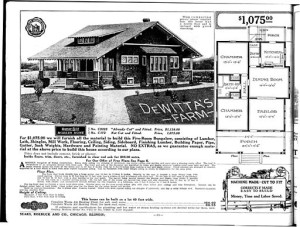
“The Hazelton” (Model Nos. C2025 and C172) Sears Catalog Home appearing in the 1916 Sears Roebuck Catalog. Courtesy of Wikimedia Commons.
The popularity of the Bungalow as a charming and affordable cottage style home spread quickly throughout the country. Bungalow designs were shared in a variety of ways, by a monthly magazine edited by Gustav Stickley, a creative East coast furniture maker associated with the Mission style of furnishings and especially by the sale of plans and designs by mail. Some plans sold for as little as $5, putting a Bungalow within reach of many home builders. Books of Bungalow designs were so popular that all three editions were sold out by the publisher. Bungalow designs were very marketable because of their affordability and adaptability to various settings and materials. They were also very appealing due to their open and less formal floorplan. The design of the Bungalow was a departure from the old fashioned styles of the past, so to many new home builders it seemed “modern” and appropriate for the early years of a new century. Sears sold Bungalow plans and house kits, as did other build-it-yourself home manufacturers. Bungalow cottages flourished as mail order homes with kits being shipped by rail all over the country for assembly everywhere.
Regional variations on the Bungalow design theme developed based on climate, economics and local preferences. California remains a Bungalow lovers delight with a multitude of fanciful storybook embellishments on the Bungalow plan. There are a number of Bungalow variants which are often hybrids of several styles popular at the turn of the century. Some of those common variants show design details from the Spanish Mission Revival, Dutch Revival (gambrel roof), Tudor Revival, Art Moderne and Swiss Chalet styles. Log built or rustic design Bungalows are sometimes called Adirondack Bungalows in recognition of where they were often found. Surface details may link Bungalows to other styles, but the basic form is usually unchanged.
Here in Pennsylvania Bungalows often have Craftsman details like heavy columns, wide chimneys, a deep porch and gabled dormers. Bungalows can be found in most Pennsylvania communities where the population was increasing in the early 20th century. While some of the best examples of Bungalow design often feature the use of stone or brick, wall materials may also be of stucco or wood. Whatever their exact form, Bungalows are charming additions to any historic streetscape. They are often found in streetcar suburbs (neighborhoods which developed along early streetcar lines) in cities and smaller communities throughout the state. They remain a cherished part of Pennsylvania’s residential architectural history and their welcoming front porches encourage all to sit and visit.
- St. Marys City, Elk County. Photo by Bryan Van Sweden, PHMC.
- Newville, Cumberland County. Photo by Bryan Van Sweden, PHMC.
- Shippensburg, Cumberland County. Photo by Bryan Van Sweden, PHMC.
- New Cumberland, Cumberland County. Photo by Bryan Van Sweden, PHMC.
- Elizabethtown, Lebanon County. Photo by Bryan Van Sweden, PHMC.
- Camp Hill, Dauphin County. Photo by Bryan Van Sweden, PHMC.
- Tunkahannock, Wyoming County. Photo by Bryan Van Sweden, PHMC.
- Abingdon Township, Lackawanna County. Photo by Bryan Van Sweden, PHMC.
- Erie, Erie County. Photo by Bryan van Sweden, PHMC.
- Yeadon, Delaware County. Photo by Bryan Van Sweden, PHMC.
Do you have a favorite Bungalow photo to share? Please send them to the PA SHPO so we can add to our photo archives.
Comment Policy
PHMC welcomes and encourages topic-related comments on this blog. PHMC reserves the right to remove comments that in PHMC’s discretion do not follow participation guidelines.
Commenters and Comments shall be related to the blog post topic and respectful of others who use this site.
Commenters and Comments shall not: use language that is offensive, inflammatory or provocative (this includes, but is not limited to, using profanity, obscene, or vulgar comments); disparage other commenters or people; condone illegal activity; identify the location of known or suspected archeological sites; post personal information in comments such as addresses, phone numbers, e-mail addresses or other contact details, which may relate to you or other individuals; impersonate or falsely claim to represent a person or an organization; make any commercial endorsement or promotion of any product, service or publication.
If you would like to comment on other topics not related to this blog post but related to PHMC, please fill out the PHMC Contact Us Form.
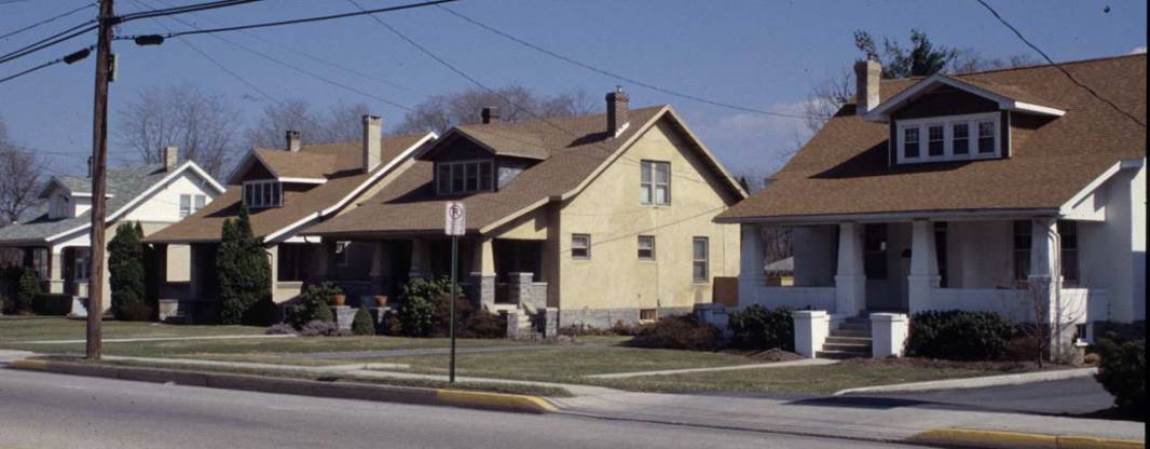
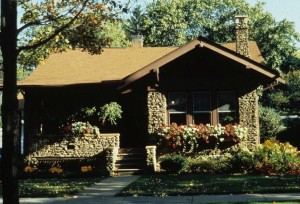

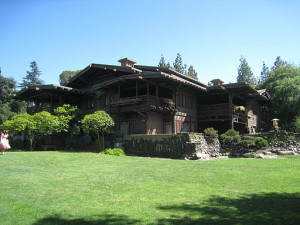
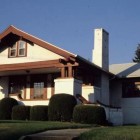

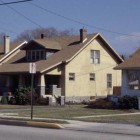
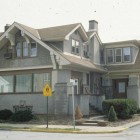
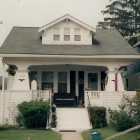
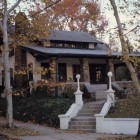
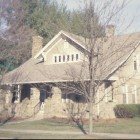
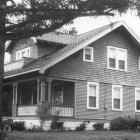
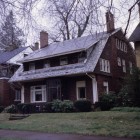
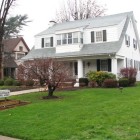
Love the columns on the Abingdon Township home…classic Sears craftsman hallmark!
Although my daughter’s house is classified as a bungalow by the taxing authority, after reading this article, I don’t think it is. I think they are calling anything with very little square foot (1,200 sf) a bungalow.
Exactly right, Bungalows flourished in California, especially in the early 20th century.
Accurately just, Bungalows developed in California, particularly in the quickly 20th century.